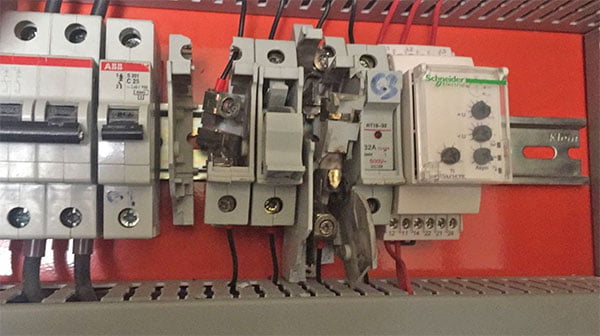The Need for Surge Protection
Introduction

The probability of electronic systems being damaged by lightning is many times greater than that of the building itself being struck by lightning!
Why?
Imagine a building. It’s a relatively small target for lightning to hit, yet we will spend money on installing structural protection and have it tested annually, but ignore the dangers posed by lightning induced transients or surges.
Our homes, places of work, factories, offices, hospitals, airports, etc are all interconnected by overhead and buried cables forming a huge spider’s web, that is easily affected by lightning.
Fact
Lightning up to 1km away can damage electronic systems. Now, draw a 2km diameter circle around your building – that is a large target area for lightning to hit, compared to the size of the building itself.
The resultant mains borne transients from the secondary effects of lightning can be as high as 6,000 volts and have the capacity to destroy electronic systems. Smaller transients may cause degradation to electronic components and disruption of system performance.
But the threat to electronic systems does not end there. Transient voltages caused by electrical switching are common.

Dependency
Electronic systems have invaded our everyday lives and we now depend on them to a huge extent:
- Business (where such systems control administration and manufacturing operations),
- Hospitals (where our lives can depend on the functioning of electronic equipment),
- Security services (police, fire and ambulance),
- Leisure (when we go shopping or even to the cinema or entertainment complex)
- Personal communications (email and phone).




Susceptibility
Given that electronic systems are a vital part of everyday life and have become increasingly miniaturised over the past decades, protecting them from surges is more important than ever. If they were left unprotected and damaged by a transient overvoltage this could result in major inconvenience, lack of service and potentially life-threatening situations.
We can also see that the electronics supporting our everyday lives have become increasingly sophisticated and miniaturised. So much so that they are now more susceptible to damage or degradation.
Put this in the context of a 2km diameter target area for lightning – a spiders web of power and data cables – then we have a recipe for disaster!
Imagine what would happen if we didn’t have these systems – inconvenience, lack of service, perhaps even life threatening situations.
The consequences to operators of such systems are damage, degradation, and disruption.
All of this can be costly but the good news is that it can be prevented!

Problems caused by transients
Damage
This can range from burnt-out circuit boards to impaired operation of components.
Disruption
Disruption to the logic levels of the device rather than physical damage, resulting in data loss, software corruption and unexplained computer crashes.
Degradation
Long term exposure to transients can result in invisible degradation of electrical components.
Downtime
Resulting from inoperative systems.
Consequential loss
Consequential loss is the inability to use the electronic system –
this can be extremely expensive and includes, but is not limited to:
- Replacement hardware
- Replacement software
- Loss of service
- Loss of revenue from suspended sales or manufacturing/process activity
- Cost of labour
The loss (or cost) varies from organisation to organisation, but it is not only inconvenient to have these problems, they can be prevented.
It is vitally important to reduce the size of lightning induced transients from 6,000 volts, to below the withstand voltage of the equipment to be protected (often cited as 1,500 volts).
This is the performance of European type units and the new Kingsmill range.

